 Chef: Chan Yan-Tak Website: www.fourseasons.com/hongkong Cuisine: Cantonese
Chef: Chan Yan-Tak Website: www.fourseasons.com/hongkong Cuisine: Cantonese
On my latest fine dining trip to Hong Kong I wanted to squeeze in a good yam cha (dim sum) session but had very limited time. I also wanted to squeeze in another fine dining meal so I thought why not combine the two and go for a starred yam cha meal since there were a few around? Naturally, I couldn’t resist the opportunity of trying Hong Kong’s only three michelin starred yam cha restaurant, which also had featured on the inaugural San Pellegrino Asia’s 50 Best Restaurant list coming in at a respectable 13th place. Coincidentally, the Four Seasons Hotel which houses the restaurant is also home to another three starred French restaurant, Le Caprice, but I couldn’t quite fit it in my schedule this time around. Perhaps next time.
 The name Lung King Heen which means “view of the dragon”, is befitting for the panoramic view of the Victoria harbour, although I must admit there are better views in Hong Kong. Nevertheless, at under £30 a person for a meal, albeit not the tasting menu, I did wonder whether the food would do the view justice as I could not envisage how yam cha could be elevated to a three Michelin star standard. Given the hype and media coverage including San Pellegrino, I was convinced that there had to be something amazing about this restaurant so I made a reservation for two in hope for a divine meal that would satisfy my yam cha craving. My verdict on the restaurant you ask? You’ll have to read on…
The name Lung King Heen which means “view of the dragon”, is befitting for the panoramic view of the Victoria harbour, although I must admit there are better views in Hong Kong. Nevertheless, at under £30 a person for a meal, albeit not the tasting menu, I did wonder whether the food would do the view justice as I could not envisage how yam cha could be elevated to a three Michelin star standard. Given the hype and media coverage including San Pellegrino, I was convinced that there had to be something amazing about this restaurant so I made a reservation for two in hope for a divine meal that would satisfy my yam cha craving. My verdict on the restaurant you ask? You’ll have to read on…
 We were initially offered a choice of tea, juice or water to start. For some reason I have a habit of only drinking jasmine tea so we opted for that. I find that tea in yam cha establishments can sometimes be overlooked so it was good to see them offering us a variation in strength. In addition to the familiar dishes, we opted for a couple of suggestions made by our waitress.
We were initially offered a choice of tea, juice or water to start. For some reason I have a habit of only drinking jasmine tea so we opted for that. I find that tea in yam cha establishments can sometimes be overlooked so it was good to see them offering us a variation in strength. In addition to the familiar dishes, we opted for a couple of suggestions made by our waitress.
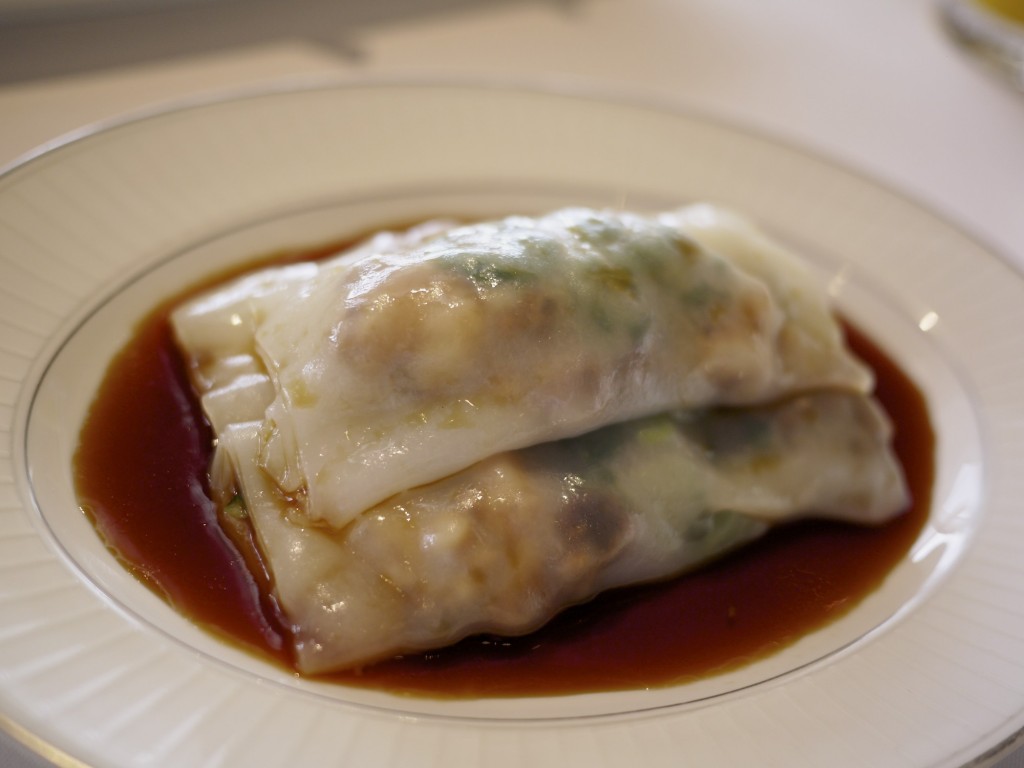 First up was the most expensive dish of the meal and one which they suggested – Steamed rice rolls with lobster in fermented bean sauce (cheung fun). I’m quite picky about rice rolls and there’s a lot of skill required to make a good one. It need to be fresh, thin yet tender, and it needs to have a mild sweetness on its own. The “garnishes”, in this case the lobster, and the sauce needs to complement the roll but not distract it. Suffice to say, the roll was very good here but I found the lobster almost non-existent other than providing only a textural element and the black bean sauce overpowered the dish. What a shame!
First up was the most expensive dish of the meal and one which they suggested – Steamed rice rolls with lobster in fermented bean sauce (cheung fun). I’m quite picky about rice rolls and there’s a lot of skill required to make a good one. It need to be fresh, thin yet tender, and it needs to have a mild sweetness on its own. The “garnishes”, in this case the lobster, and the sauce needs to complement the roll but not distract it. Suffice to say, the roll was very good here but I found the lobster almost non-existent other than providing only a textural element and the black bean sauce overpowered the dish. What a shame!
 Much better from the next dish of Baked barbecued pork buns with pine nuts. In absence of my most favourite dish to my disappointment which is the steamed variation (char siu pau), we were glad to have chosen this dish. The bun had a lovely fluffed up butter crust on top and was slightly sweet, enhancing the flavour of the moist pork, which was of superior quality. I particularly liked the slight crunch from the vegetable inside and it showed the chef’s attention and respect to each ingredient.
Much better from the next dish of Baked barbecued pork buns with pine nuts. In absence of my most favourite dish to my disappointment which is the steamed variation (char siu pau), we were glad to have chosen this dish. The bun had a lovely fluffed up butter crust on top and was slightly sweet, enhancing the flavour of the moist pork, which was of superior quality. I particularly liked the slight crunch from the vegetable inside and it showed the chef’s attention and respect to each ingredient.
 We couldn’t have yam cha without the classic Steamed shrimp dumpling with asparagus (har gow), which again contained a very fresh and flavoursome prawn inside with chopped asparagus sprinkled on top. As expected, the prawn came in it’s entirety retaining a lot of the delicate juice and flavour, contrary to many yam cha places which serve them chopped up and the flavour lost. A simple dish but well executed.
We couldn’t have yam cha without the classic Steamed shrimp dumpling with asparagus (har gow), which again contained a very fresh and flavoursome prawn inside with chopped asparagus sprinkled on top. As expected, the prawn came in it’s entirety retaining a lot of the delicate juice and flavour, contrary to many yam cha places which serve them chopped up and the flavour lost. A simple dish but well executed.
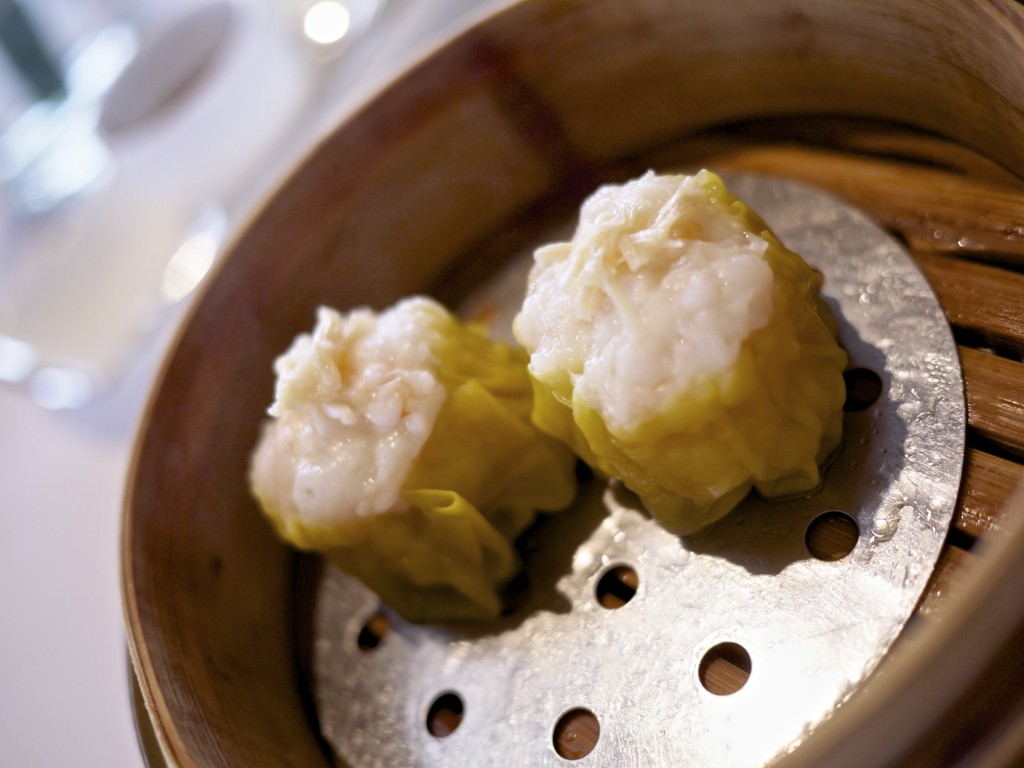 Another classic dish of a rather giant Steamed shrimp and pork dumplings with conpoy (shiu mai). This dish is a difficult one to rate because I personally think it all depends on each individual’s preference. I prefer mine to have a higher prawn-to-pork ratio but quite often I find the pork flavour to be dominant. It wasn’t the case here and I rather enjoyed this simple dish.
Another classic dish of a rather giant Steamed shrimp and pork dumplings with conpoy (shiu mai). This dish is a difficult one to rate because I personally think it all depends on each individual’s preference. I prefer mine to have a higher prawn-to-pork ratio but quite often I find the pork flavour to be dominant. It wasn’t the case here and I rather enjoyed this simple dish.
 I took a particular liking for the next course during my trip in China in 2011 so I was looking forward to the Steamed Shanghainese pork dumplings with scallops (Xiao long bao). The chef clearly thought about serving this dish in the easiest manner using the little wooden rack. What a great idea! This way I did not risk losing the all important soup. However, the skin was unfortunately thicker than the translucent ones I had in Shanghai. The addition of the scallop was a novelty for me as I never across this variation in China but I must admit that the soup inside was a tad too cold for my liking and the dish overall was disappointing.
I took a particular liking for the next course during my trip in China in 2011 so I was looking forward to the Steamed Shanghainese pork dumplings with scallops (Xiao long bao). The chef clearly thought about serving this dish in the easiest manner using the little wooden rack. What a great idea! This way I did not risk losing the all important soup. However, the skin was unfortunately thicker than the translucent ones I had in Shanghai. The addition of the scallop was a novelty for me as I never across this variation in China but I must admit that the soup inside was a tad too cold for my liking and the dish overall was disappointing.
 Another recommendation by the waitress of the Crispy spring rolls with assorted seafood which had a lovely golden-brown crispy pastry with a distinct texture and flavour of fresh prawn again. I thought the contrast of juicy prawns and crispy pastry was executed perfectly, and if there was one thing about this place the ingredients were really fresh and of high quality. But after all, it was simply just a spring roll?
Another recommendation by the waitress of the Crispy spring rolls with assorted seafood which had a lovely golden-brown crispy pastry with a distinct texture and flavour of fresh prawn again. I thought the contrast of juicy prawns and crispy pastry was executed perfectly, and if there was one thing about this place the ingredients were really fresh and of high quality. But after all, it was simply just a spring roll?
 We were still quite peckish so opted for two additional dishes. The first one was the Baked roast goose puffs with chestnut in X.O chilli sauce. I didn’t particularly like this dish as my palate was dominated by the sweet chestnut rather than the roast goose. Admittedly, I can’t remember ever seeing chestnut in a yam cha course?
We were still quite peckish so opted for two additional dishes. The first one was the Baked roast goose puffs with chestnut in X.O chilli sauce. I didn’t particularly like this dish as my palate was dominated by the sweet chestnut rather than the roast goose. Admittedly, I can’t remember ever seeing chestnut in a yam cha course?
 Last course of the meal was Steamed chicken dumplings with mushrooms and parsley.The nuttiness really came through and the chicken was again surprisingly moist and the vegetable fresh and crunchy. Not a bad dish to finish off on.
Last course of the meal was Steamed chicken dumplings with mushrooms and parsley.The nuttiness really came through and the chicken was again surprisingly moist and the vegetable fresh and crunchy. Not a bad dish to finish off on.
 We had some petit fours which again were not something to get excited over. The chef came out towards the end of the meal but only to greet one person who was sitting two tables away and using flash photography for each course.
We had some petit fours which again were not something to get excited over. The chef came out towards the end of the meal but only to greet one person who was sitting two tables away and using flash photography for each course.  So my verdict? I think we need to put things into context. Yes, the ingredients and produce incorporated in the dishes were fresh and better than the average yam cha restaurant. The ambiance inside was relaxing, although the crowded noisy ones on the busy streets of Hong Kong are charming in their own right. But was this restaurant truly a three michelin starred restaurant? If you take Michelin’s definition of three stars which is “exceptional cuisine, worth a special journey,” then I think this place fails dramatically on all front. The service was decent but not spectacular. It took us 20 minutes to get attention to pay our bill. The view was great but I’ve had better in Hong Kong who don’t even have two stars. I have on many occasions flown out on special journies for the sole purpose of dining, and frequently been able to justify the effort on the back of just one extraordinary meal like at Oaxen Krog or on the rarer occasions just one dish like the Herefordshire steak at Ledoyen. It was clearly not the case here and I was glad this was not my primary purpose of visit to Hong Kong. Don’t get me wrong, I did enjoy the meal, especially given the price, but this restaurant simply does not pass muster nor live up to the hype.
So my verdict? I think we need to put things into context. Yes, the ingredients and produce incorporated in the dishes were fresh and better than the average yam cha restaurant. The ambiance inside was relaxing, although the crowded noisy ones on the busy streets of Hong Kong are charming in their own right. But was this restaurant truly a three michelin starred restaurant? If you take Michelin’s definition of three stars which is “exceptional cuisine, worth a special journey,” then I think this place fails dramatically on all front. The service was decent but not spectacular. It took us 20 minutes to get attention to pay our bill. The view was great but I’ve had better in Hong Kong who don’t even have two stars. I have on many occasions flown out on special journies for the sole purpose of dining, and frequently been able to justify the effort on the back of just one extraordinary meal like at Oaxen Krog or on the rarer occasions just one dish like the Herefordshire steak at Ledoyen. It was clearly not the case here and I was glad this was not my primary purpose of visit to Hong Kong. Don’t get me wrong, I did enjoy the meal, especially given the price, but this restaurant simply does not pass muster nor live up to the hype.



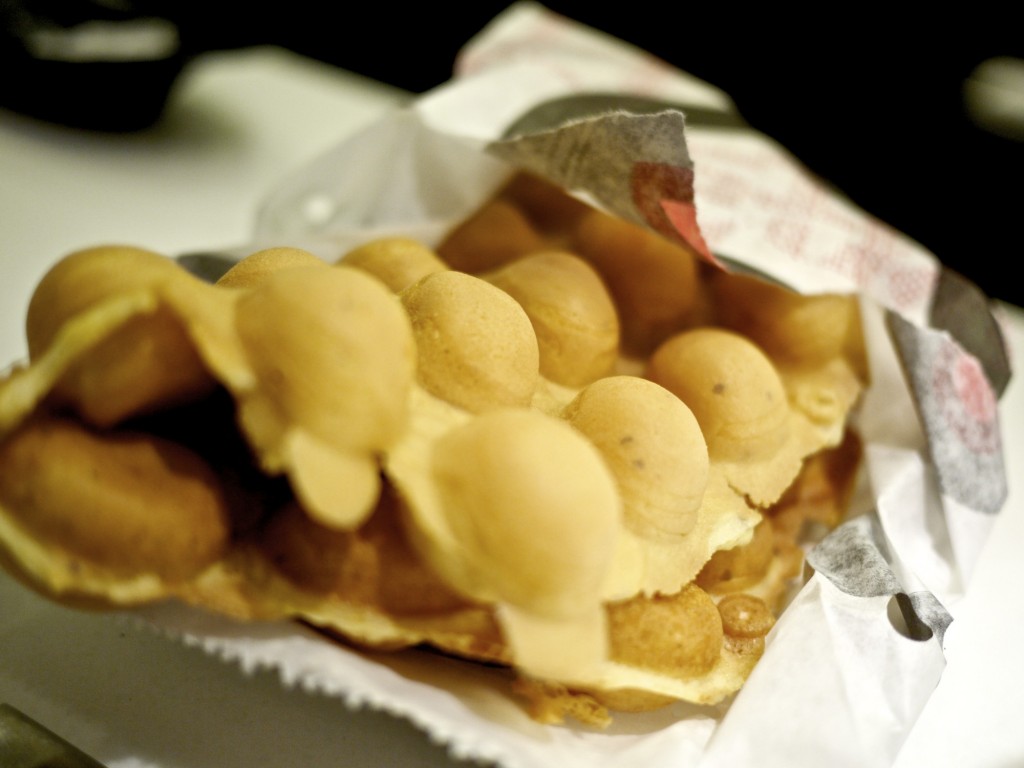












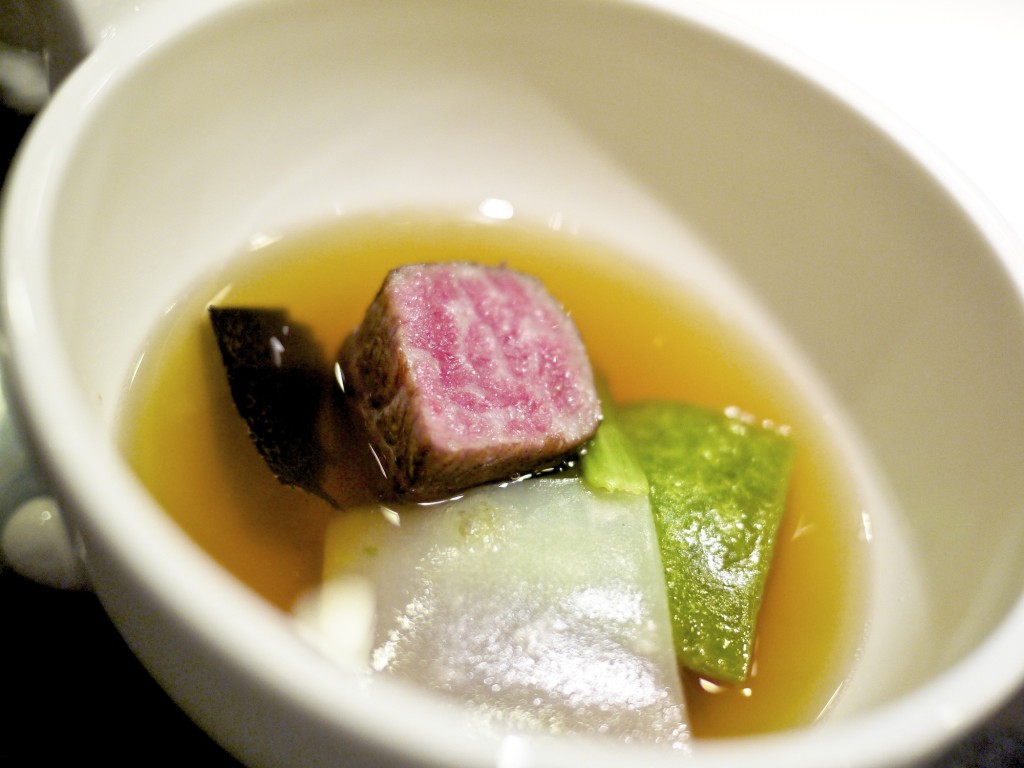











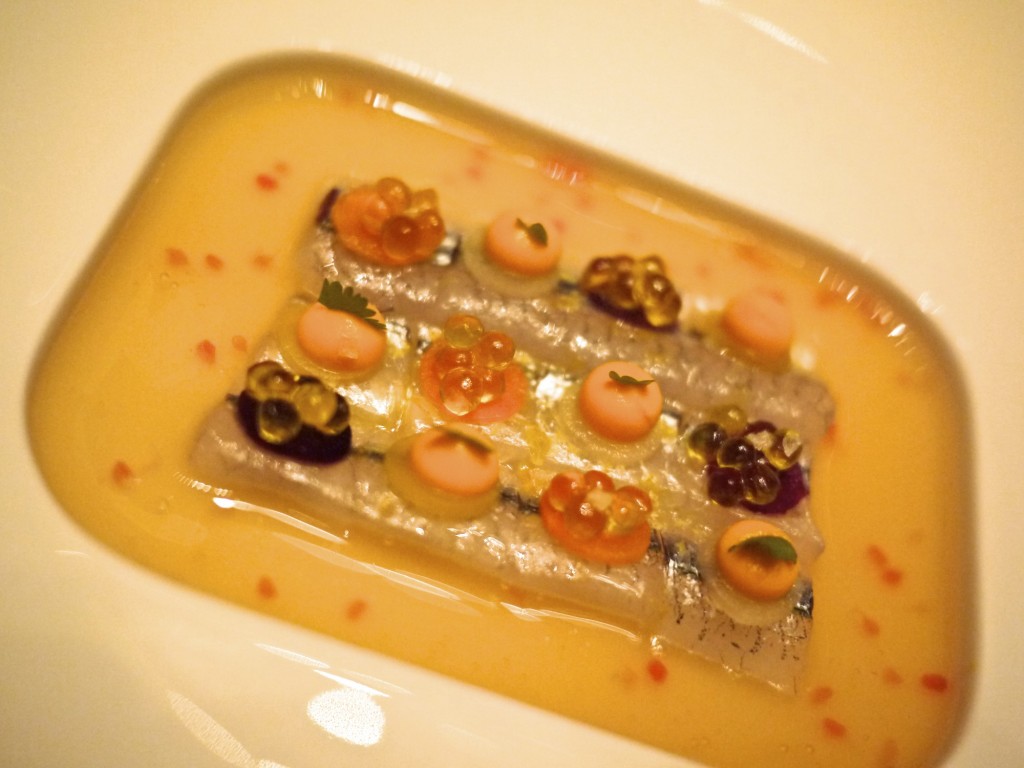






 We expected to be served our main meat course next but Chef Ekkebus decided to make a last minute change and incorporate one last seafood dish, which ended up being the best dish of the night! We were fortunate enough to have been served with an off-the-menu special course of the ‘ebisu’ oyster. This had been cooked in its shell at 67 degrees and was served with wilted tetragon, shallots, duck gizzard, pieds de moutons mushroom and vin jaune. It was truly a jaw-dropping dish that married European and Asian techniques, ingredients and flavours. I had never encountered this unique combination, which started off rich and deep from the amalgamation of the ingredients and ended with the clean finish of the oyster hiding underneath. My companion and I had no words to exchange other than the look of bewilderment and delight, interrupted only with nodding heads each time we took a bite!
We expected to be served our main meat course next but Chef Ekkebus decided to make a last minute change and incorporate one last seafood dish, which ended up being the best dish of the night! We were fortunate enough to have been served with an off-the-menu special course of the ‘ebisu’ oyster. This had been cooked in its shell at 67 degrees and was served with wilted tetragon, shallots, duck gizzard, pieds de moutons mushroom and vin jaune. It was truly a jaw-dropping dish that married European and Asian techniques, ingredients and flavours. I had never encountered this unique combination, which started off rich and deep from the amalgamation of the ingredients and ended with the clean finish of the oyster hiding underneath. My companion and I had no words to exchange other than the look of bewilderment and delight, interrupted only with nodding heads each time we took a bite!




